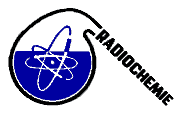Speaker
Dr
Zoltán Németh
(University of Pannonia Institute of Radiochemistry and Radioecology)
Description
Decontamination technologies are generally developed to reduce the collective dose of the maintenance and operation personnel at NPPs. The highest efficiency (i.e., the highest DF values) available without detrimental modification of the treated surface of structural material is the most important goal in the course of the application of a decontamination technology. The AP-CITROX procedure has mainly been used for the decontamination of the primary coolant circuit’s components (e.g. main circulating pump (MCP) and steam generators (SGs)) at the Paks NPP. While decontamination of the dismountable devices (e.g. main circulating pump) has been carried out in big tanks with heating potential, separable equipments (e.g. heat exchangers) have been treated with special decontamination facilities.
The AP-CITROX procedure was used 24 times for the SGs decontamination at units 1-3 of the Paks NPP during the period of 1993-2001. Our previous studies have revealed that a ”hybrid” structure of the amorphous and crystalline phases is formed in the outermost surface region of the austenitic stainless steel tubes of SGs as an undesired consequence of the industrial application of the AP-CITROX decontamination technology.
In this presentation, we report some comparative findings on the corrosion and surface analytical effects of the AP-CITROX procedure and the decontamination technology elaborated at our institution. After optimizing its operational parameters the latter technology is suitable for the decontamination of both dismountable (e.g. MCP swivel) and separable (e.g. heat exchanger) equipments. In this semi-plant scale experiments, the passivity, morphology and chemical compositions of the treated surfaces of tube specimens were investigated by voltammetry, and SEM-EDX methods.
The newly developed decontamination technology can be effectively applied for the decontamination of the austenitic stainless steel samples; the total oxide-layer can be removed by this technique. The SEM-EDX results revealed that the oxide removal is surprisingly uniform even after 2 or 3 consecutive cycles. The electrochemical studies provided evidences that no unfavorable tendencies in the general corrosion state of the tube samples can be detected in the course of the chemical treatments.
Keywords: decontamination, AP-CITROX, voltammetry, SEM-EDX
Primary author
Dr
Zoltán Németh
(University of Pannonia Institute of Radiochemistry and Radioecology)
Co-authors
Andrea Szabó Nagy
(University of István Széchenyi Department of Physics and Chemistry)
Bernadett Baja
(University of Pannonia Institute of Radiochemistry and Radioecology)
Gábor Patek
(Paks NPP)
János Schunk
(Paks NPP)
Krisztián Radó
(University of Pannonia Institute of Radiochemistry and Radioecology)
Kálmán Varga
(University of Pannonia Institute of Radiochemistry and Radioecology)

